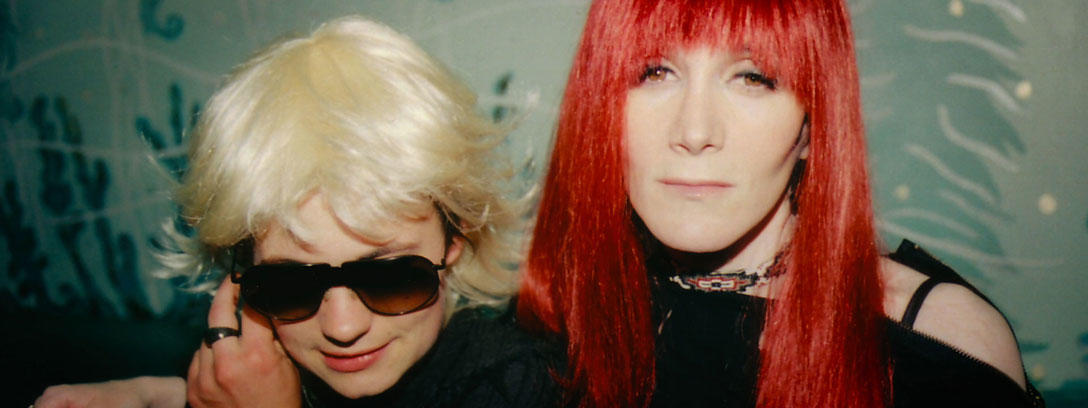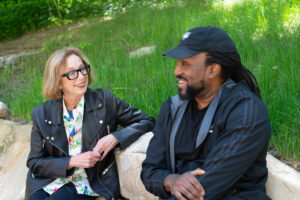Savannah Knoop (JT LeRoy) and Laura Albert. Credit: Dogwoof
Jeremy Kinser
If you followed pop
culture in the late ’90s, the name JT LeRoy was inescapable and in many ways
inscrutable. Thought to be a 15 year-old, drug-abusing transgender prostitute
from rural West Virginia, LeRoy’s byline began to appear in magazines. Soon,
two novels,
Sarah and The
Heart Is Deceitful Above All Things
, were published to great acclaim and
even greater fanfare. LeRoy began hobnobbing with scene makers such as Courtney
Love, Bono, and Gus Van Sant.
There was no real LeRoy. He’d been the creation
of Laura Albert, a talented, seductive middle-aged phone sex-operator from
Brooklyn who used her androgynous friend Savannah Knoop to impersonate LeRoy,
who she considered her “avatar,” in a floppy blond wig, dark glasses and a
black hat. As people became more curious and, perhaps naturally, more
suspicious of LeRoy, the truth was eventually uncovered by an investigative
journalist in
The New York
Times
in 2006 and the ruse
was widely hailed as “the literary hoax of the century.”
In 2005 Jeff
Feuerzeig premiered
The Devil
and Daniel Johnston, a compelling chronicle of the fascinating cult
musician and artist, at Sundance and took home the Directing Award in the
Documentary Competition for his effort. Since then he’s helmed
The Real Rocky, a look at boxer
Chuck Wepner, believed to have inspired the Sylvester Stallone franchise; co-written (with pal Jerry Stahl) a screenplay titled
The Bleeder,
about Wepner’s 1975 match against heavyweight champ Muhammad Ali; and now returns to Sundance with
Author: The JT LeRoy Story.
Feuerzeig recently
spoke with Sundance about how he convinced Laura Albert to tell her side of the
story, his love of subjective filmmaking, and how winning a Sundance directing
award a decade ago affected his career.
What is it about JT
LeRoy’s story that continues to keep us so spellbound?
When I got turned
on to the story a few years ago by a friend who is a journalist — he knows how
much I love unique stories — he thought I’d enjoy it. I’d heard of JT LeRoy but
didn’t know anything about him. There are a lot of major publications [that]
had weighed in on this story.
The New York Times had covered it elaborately. Rolling Stone and Vanity Fair did a huge piece – so did Salon.com. I
read all these pieces and everyone had something to say.
The hook, of course,
was this is the greatest literary hoax of our time. There was just one voice
missing from all these elaborate think pieces and it was the person who wrote
the books. She had never told her story. That was the story I wanted to hear. I
sought out Laura Albert. She had been exposed by
The New York Times.
She had seen
The Devil and
Daniel Johnston
and based on
that she trusted me.
I wanted to give her a forum to tell her story. It’s a
very subjective film. I loved
The
Kid Stays in the Picture
and Tyson and Jerry Stahl’s I, Fatty. I love first-person
narration journeys. That’s the kind of storytelling I enjoy. I’m not interested
in judging. I’m interested in going on an antihero’s journey.
In other hands,
this could easily have become an indictment against Laura. How did you convince
her to let you tell her story?
Very simply. She
watched
The Devil and Daniel
Johnston
and that was enough.
I find the intersection of art and madness infinitely fascinating. Daniel
Johnston, like Laura Albert, [is] off the spectrum. At the time I had not yet
read her books. I only knew her story and wanted to know if she’d be
interested. It was really
The
Devil and Daniel Johnston. It didn’t hurt that we’d both come out of punk
rock. That meant something to her.
Then I read her books. It was very important
for me to experience her art. I absolutely loved the books. It didn’t surprise
me.
Sarah and The Heart is Deceitful Above All
Things
were international
bestsellers. They were well-reviewed. These books were a zeitgeist moment in
transgressive fiction. It’s not J.K. Rowling. This is tough material. It’s very
rare to pack bookstores around the world like a rock concert. It’s tough to get
17 friends to come to a bookstore for a reading so how did this happen? [
Laughs]
I’m a big Southern Gothic fan and I loved Flannery O’Conner’s writing in
college.
It was an aspect of literature I’d explored, along with Tennessee
Williams. I was hooked by the story and I loved the art, but I wondered,
‘What’s the story behind the story? How
did it happen and why did it happen?’ Those,
of course, were unknowns. The one part of this puzzle that was missing is what
this film will hopefully fill in. It doesn’t negate the other accounts of the
story.

Laura described JT
as her avatar, but she had other personas, including Speedie, a confidant of
JT’s. It’s quite a tangled web. How would you describe her?
I can’t diagnose
her. I’m not a psychologist or a psychiatrist. I didn’t diagnose Daniel
Johnston, either. We learned he’s bipolar, but he has a lot of other things
going on. When you’re on the spectrum of DSM-IV, and she’s on the spectrum… The
point is she’s clearly super-intelligent. As an artist, she’s very, very
talented. As far as where she is on the spectrum, it’s for people with bigger
degrees than me to decide.
The structure you
use is perfect for such a complex story. It’s as if you’re peeling back layers
until the full truth is revealed.
The film is a
tapestry. Her A-story is the anti-hero’s journey in three very careful acts I
constructed because the structure of the film was very complicated to figure
out because the story was so complicated. Of course, the other strand is her
backstory and how it all comes together. It’s like
Memento. The
backstory is playing out in reverse and catches up to itself. That was by
design. I give you information, you carry it with you then I give you more
information. There’s hopefully satisfaction at the end when it all comes
together.
She gave you access
to a stunning amount of archival footage. The answering machine messages left
by JT’s celeb friends defending him when the exposé was published is a highlight
of the film.
Her archive was
incredible. It’s all the photos, all the audio and almost all the video. It’s
somebody who had an entire archive of her life, so it was an incredible gift
for me. As a non-fiction filmmaker, my goal is to create the most immersive
experience I can give you… I’m hoping that if you go along on this ride and I
construct it carefully, you can forget it’s a documentary and it plays like a
narrative film and I’ve done my job. That’s my goal.
How do you think
her books would have been received if they’d been published under her real
name?
It’s an
unanswerable question. I’ve talked to a lot of other writers about this. If the
film does anything, I hope, it takes you inside what it’s like to be the writer
of fiction. What is fiction? I’m in the W.G.A. I write screenplays. Anybody who
is a writer who writes characters is channeling those characters. You have to
write voices. Writers write male and female voices. The characters ultimately
live inside them and talk to them and they have to put it on the page. She’s
hardly the first person on earth to use a pseudonym. We just now find out why
she used a pseudonym.
You directed The Real Rocky about Chuck Wepner, and your script The Bleeder has been made into a feature with
Liev Schrieber and Naomi Watts. What’s the commonality between this and
JT LeRoy and The Devil and Daniel Johnston?
You seem to be drawn to very complex, enigmatic characters?
They’re all
different flavors. To me, story is king. When I go to the movies I want to see
a well-told story with twists and turns that I can’t predict. It’s such a cliché
to say this but obviously truth is stranger than fiction. I love true stories
so I seek them out. I’m just trying to apply the new journalism that inspired
me: Tom Wolfe, Gay Talese, Terry Southern, Hunter Thompson – those writers all
blew my mind. They inspired me to try to apply that to my version of
non-fiction filmmaking. I’m looking for a deeper truth.
You won the Directing
Award at Sundance in 2005. How did that affect your career?
That put me on the
map. I’ve been a commercial director my whole life, but that’s the reason
The Real Rocky got made – and The Bleeder. I’m a working
filmmaker because of that. I don’t write on spec. It’s the greatest thing that
ever happened. It was my dream to just continue to make films and that
directing prize put me on the map.




